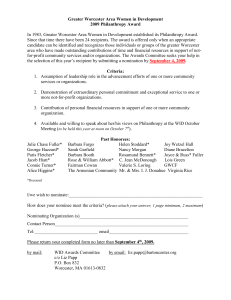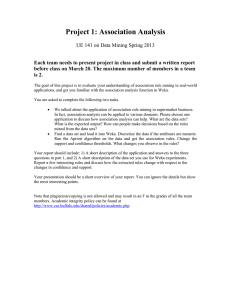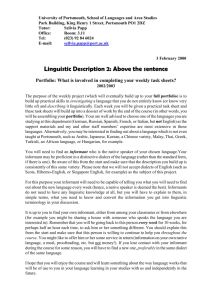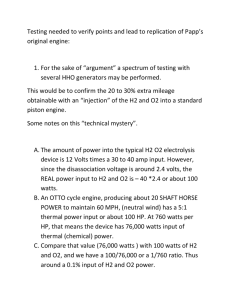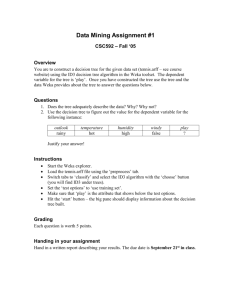Susceptibility of four bird species to para-aminopropiophenone (PAPP)
advertisement
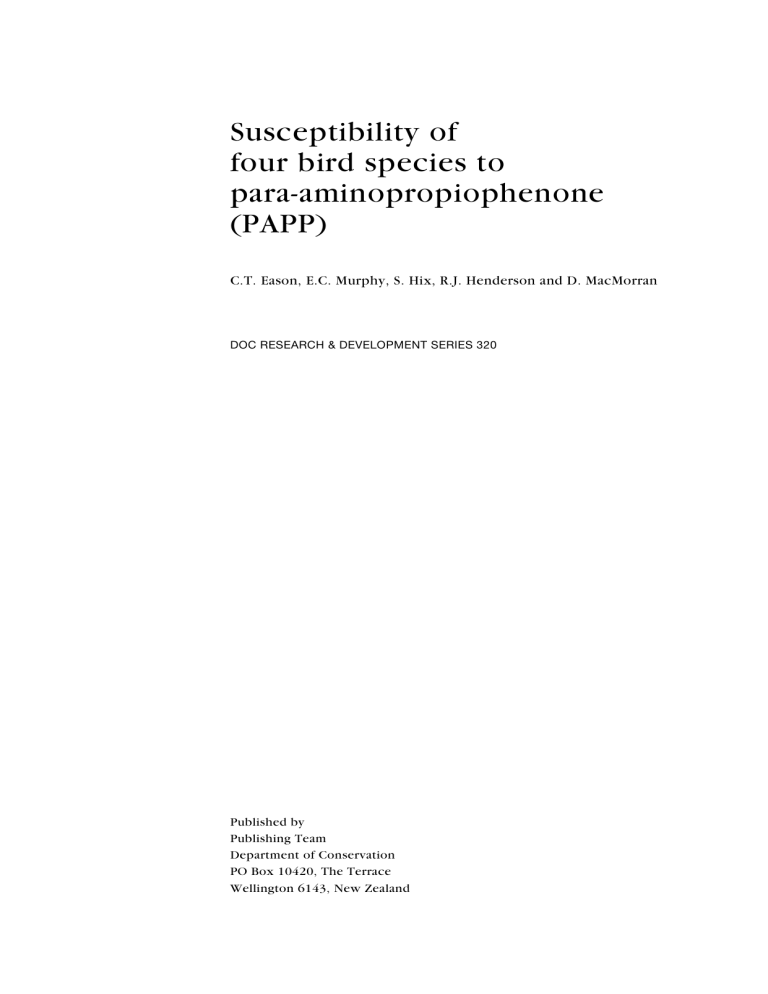
Susceptibility of four bird species to para-aminopropiophenone (PAPP) C.T. Eason, E.C. Murphy, S. Hix, R.J. Henderson and D. MacMorran DOC Research & Development Series 320 Published by Publishing Team Department of Conservation PO Box 10420, The Terrace Wellington 6143, New Zealand DOC Research & Development Series is a published record of scientific research carried out, or advice given, by Department of Conservation staff or external contractors funded by DOC. It comprises reports and short communications that are peer-reviewed. Individual contributions to the series are first released on the departmental website in pdf form. Hardcopy is printed, bound, and distributed at regular intervals. Titles are also listed in our catalogue on the website, refer www.doc.govt.nz under Publications, then Science & technical. © Copyright February 2010, New Zealand Department of Conservation ISSN ISSN ISBN ISBN 1176–8886 (hardcopy) 1177–9306 (web PDF) 978–0–478–14735–3 (hardcopy) 978–0–478–14736–0 (web PDF) This report was prepared for publication by the Publishing Team; editing by Amanda Todd and layout by Hannah Soult. Publication was approved by the General Manager, Research and Development Group, Department of Conservation, Wellington, New Zealand. In the interest of forest conservation, we support paperless electronic publishing. When printing, recycled paper is used wherever possible. C ontents Abstract 5 1. Introduction 6 2. Methods 7 2.1 Australian magpies 7 2.2 Blackbirds 7 2.3 Mallard ducks 8 2.4 Weka 8 3. Results 9 3.1 Australian magpies 9 3.2 Blackbirds 10 3.3 Mallard ducks 10 3.4 Weka 11 3.5 Toxicity of PAPP across species 13 4. Discussion 13 5. Acknowledgements 14 6. References 15 Susceptibility of four bird species to para-aminopropiophenone (PAPP) C.T. Eason 1,2, E.C. Murphy 3, S. Hix2, R.J. Henderson 4 and D. MacMorran 2 1 Lincoln University, PO Box 84, Lincoln 7640, New Zealand Email: charlieeason@xtra.co.nz 2 Connovation Ltd, PO Box 58613, Manukau 2141, New Zealand 3 Department of Conservation, PO Box 13049, Christchurch 8141, New Zealand 4 Pest Tech Ltd, PO Box 40, Leeston 7656, Canterbury, New Zealand A bstract The suitability of para-aminopropiophenone (PAPP) for the humane control of stoats (Mustela erminea) and feral cats (Felis catus) is being investigated in New Zealand. Birds are potential non-targets that may be affected by this toxin. Therefore, the objective of this study was to test the toxicity of a proprietary formulation of PAPP in four bird species: Australian magpies (Gymnorhina tibicen; n = 40), blackbirds (Turdus merula; n = 20), mallard ducks (Anas platyrhynchos Pekin breed; n = 20) and weka (Gallirallus australis; n = 21). Birds were orally dosed with PAPP in the form of a 40% paste that had been added to meat as a delivery vehicle. The lethal dose to kill 50% of the sample (LD 50) was 1387 mg/kg for magpies, 174 mg/kg for blackbirds, 32 mg/kg for mallard ducks and 568 mg/kg for weka. However, the LD 50 value for weka underestimates the risk to this species, as individuals were affected at the lowest dose tested (62 mg/kg), becoming subdued and losing their appetite until they were euthanized 30 h after dosing. Whilst birds are less susceptible to PAPP than stoats or feral cats (LD 50 for both of these species is < 10 mg/kg), some bird species are adversely affected, so it will be important to limit their exposure. Keywords: para-aminopropiophenone, PAPP, LD 50, Australian magpie, Gymnorhina tibicen, blackbird, Turdus merula, mallard duck, Anas platyrhynchos, weka, Gallirallus australis © February 2010, New Zealand Department of Conservation. This paper may be cited as: Eason, C.T.; Murphy, E.C.; Hix, S.; Henderson, R.J.; MacMorran, D. 2010: Susceptibility of four bird species to para-aminopropiophenone (PAPP). DOC Research & Development Series 320. Department of Conservation, Wellington. 15 p. DOC Research & Development Series 320 5 1. Introduction Stoats (Mustela erminea) were shipped to New Zealand from Britain in the 1880s and released on farmland in the hope that they would control rabbit (Oryctolagus cuniculus) numbers. Unfortunately, they soon spread throughout the country, including to places where there were no rabbits (King & Murphy 2005). Cats (Felis catus) came with the European explorers and settlers from 1769 onwards, and well-established feral populations were reported in the 19th century. Cats were also introduced to many offshore and outlying islands (Gillies & Fitzgerald 2005). Both stoats and feral cats have been implicated in the ongoing decline of native New Zealand threatened species and ongoing control will be required to avert further extinctions (McLennan et al. 1996; Wilson et al. 1998; Dowding & Murphy 2001; Gillies et al. 2003). The control of both stoats and feral cats is undertaken mostly by trapping, which is labour intensive. There are no toxins currently registered for stoat control and sodium fluoroacetate (1080) is the only toxin registered for feral cat control. There is an urgent need for alternative control methods for both species. The suitability of para-aminopropiophenone (PAPP) for the humane control of these predators is currently being investigated (Fisher at al. 2005; Murphy et al. 2007). PAPP is highly active in forming methaemoglobin at the expense of the oxygen carrying capacity of the blood and this can lead to a lethal deficit of oxygen in the brain (Vanderbelt et al. 1944; Marrs et al. 1991). Because PAPP is so fast acting and there are no obvious signs of suffering, it is thought to be relatively humane (Marks et al. 2004; Fisher at al. 2005; Murphy et al. 2007). A proprietary formulation of PAPP (PredaSTOP®) has been developed by Connovation N.Z. Ltd. In pen trials, this humanely killed stoats and feral cats when delivered in a meat bait (Murphy et al. 2007). Previous studies have shown PAPP to be generally less toxic to birds than to mammalian carnivores; however, the birds were administered PAPP directly to the stomach by oral gavage (Savarie et al. 1983; Schafer et al. 1983; Fisher et al. 2008). Therefore, we wanted to assess the toxicity to birds of the formulated PAPP paste presented in a meat bait (the intended delivery mechanism in the field). Four bird species were assessed: Australian magpies (Gymnorhina tibicen), blackbirds (Turdus merula), mallard ducks (Anas platyrhynchos, Pekin breed) and weka (Gallirallus australis). 6 Eason et al.—Susceptibility of birds to PAPP 2. Methods PAPP was milled to produce a consistent particle size, mixed with carriers, made into microgranules and mixed into a proprietary paste. High performance liquid chromatography (HPLC) with methanol/water as the mobile phase and a fluorescence detector (Wright et al. 2001) was used to confirm that the paste contained 40% PAPP. The paste was then inserted into a minced beef bait. Unfortunately, the experimental protocol varied for each bird species, as described below. The LD 50 values (the dose required to kill 50% of the sample population) and 95% confidence intervals (CI) were estimated using a logistical regression model and probit analyses (Finney 1971). Approval from the Lincoln University Animal Ethics Committee was obtained prior to the start of the study. 2.1 A ustralian magpies Forty individually housed wild-caught magpies weighing between 225 g and 327 g were lightly fasted for 24 h and then presented with 10 g of minced beef containing PAPP in a paste. The magpies were divided into five groups and presented with 50 (n = 5), 100 (n = 10), 200 (n = 10), 400 (n = 10) or 800 (n = 5) mg of PAPP. The bait was either voluntarily eaten or gently force-fed (the first five birds dosed with 100 mg PAPP voluntarily fed, but the remainder were gently force-fed).The procedure for force-feeding was to place the PAPP paste, encased in a small bolus of minced beef, in the mouth and gently push it down the bird’s throat. The bird was then held with its beak shut until the bolus of meat and PAPP was swallowed. All birds were carefully observed to ensure that there was no spillage or regurgitation following dosing. The birds had free access to water before and after dosing, and the temperature at the facility was approximately 22ºC. Following dosing, the surviving birds were maintained on a cereal mix, minced beef and water for 9 days before being euthanized. 2.2 B lackbirds Twenty individually housed wild-caught blackbirds weighing between 65 g and 88 g were lightly fasted for 24 h prior to being dosed with the PAPP paste in a minced beef bolus. The blackbirds were divided into five groups (n = 4) and presented with measured amounts of paste to deliver 0, 50, 100, 200 or 400 mg/kg of PAPP. The bait was gently force-fed by dropping the meat bolus to the back of the mouth and holding the bird with its beak shut until it had swallowed. All birds were carefully observed to ensure that there was no spillage or regurgitation following dosing. The birds had free access to water before and after dosing, and the temperature at the facility was 12ºC. Following dosing, the surviving birds were maintained on fruit, earthworms, cereal and water for 5 days before being released. DOC Research & Development Series 320 7 2.3 M allard ducks Twenty individually housed Pekin mallard ducks (domestic ducks obtained from a commercial breeder) weighing between 1.25 kg and 1.92 kg were lightly fasted for 24 h prior to being presented with the PAPP paste in a minced beef bolus. The ducks were divided into four groups (n = 5) and presented with measured amounts of paste to deliver 0, 20, 40 or 80 mg/kg of PAPP. The bait was gently force-fed by dropping to the back of the mouth and holding the bird with its beak shut until it had swallowed. All birds were carefully observed to ensure that there was no spillage or regurgitation following dosing. The birds had free access to water before and after dosing, and the temperature at the facility was 20ºC. Following dosing, the surviving birds were maintained on grain (wheat and barley), minced beef and water for 14 days before being released. 2.4 W eka Twenty-one individually housed weka weighing between 640 g and 1222 g were kept in cages in a woolshed on the Chatham Islands. The weka were not fasted before the trial, as they were treated within a few hours of being caught. Initially, 20 weka were divided into five groups (n = 4) and presented with 0, 50, 100, 200 or 400 mg of PAPP. PAPP paste in a small bolus of minced beef was administered by placement at the back of the mouth followed by gentle pushing down the throat. One bird in the 400 mg PAPP group regurgitated the bait, so an extra bird was added to that group (n = 5). The birds had free access to water before and after dosing, and the temperature at the facility was c. 16ºC. Following dosing, the surviving birds were maintained on fruit, cereal, minced beef and water, and their condition was observed for 30 h. After 30 h, they were euthanized. A post mortem was carried out on two of the birds (dosed with 200 mg and 400 mg PAPP), and liver and muscle tissue samples were taken for residue analysis. These samples were analysed using HPLC with a fluorescence detector. The method detection limit (MDL) was 0.001 mg/g PAPP ± 7% (95% CI). 8 Eason et al.—Susceptibility of birds to PAPP 3. Results 3.1 A ustralian magpies Eleven out of 40 magpies died and most of these fatalities occurred at doses in the range of 1400–3101 mg/kg of PAPP (Table 1). An LD 50 of 1386.7 mg/kg (95% CI = 928.8–2882.3) was calculated. Death occurred at between 1.3 h and 50 h after dosing. There were no signs of major discomfort or stress. Some birds vomited, but this did not affect survival, and some became lethargic and then recovered. Those on very high doses became quiet, lethargic and then unconscious for a period before they died. T able 1 . E ffect of var y ing P A P P doses on magpies ( G y m n o r h i n a t i b i c e n ) . Fate: A = alive 9 days after dosing; D = died. PAPP (mg) 50 50 50 50 50 100 100 100 100 100 100 100 100 100 100 200 200 200 200 200 200 200 200 200 200 400 400 400 400 400 400 400 400 400 400 800 800 800 800 800 Dose (mg/kg) 171 168 174 177 217 444 372 356 337 318 386 306 394 351 329 797 629 730 826 760 676 683 707 820 772 1646 1550 1338 1423 1613 1379 1242 1434 1413 1413 2974 3150 3101 2867 2807 DOC Research & Development Series 320 Weight (g) 292 297 287 282 230 225 269 281 297 314 259 327 254 285 304 251 318 274 242 263 296 293 283 244 259 243 258 299 281 248 290 322 279 283 283 269 254 258 279 285 First Fate symptoms (min) 85 83 81 80 79 30 46 10 28 19 105 104 110 105 102 34 32 29 26 23 20 20 20 20 20 16 13 10 8 10 30 30 30 30 30 25 25 30 30 30 A A A A A D A A A A A A A A A A A A D A A A A A D D D A A D A A D A A D A D D D Death (h) 22.0 13.2 30.8 17.7 33.3 17.1 50.0 8.2 4.0 41.7 1.3 9 3.2 B lackbirds Eight of the 16 dosed blackbirds died, including all four that were dosed with 400 mg/kg of PAPP (Table 2). An approximate LD 50 of 174 mg/kg (95% CI = 91.4–443.8) was calculated. Onset of symptoms occurred approximately 10–40 min after dosing, and death occurred at between 1.3 h and just over 20 h after dosing. Intoxicated blackbirds showed signs of loss of coordination before either recovering or lapsing into unconsciousness for a period before they died. Survivors appeared normal after recovering over a period of 2–4 h. One bird in the control group also died—this bird may not have fully acclimatised. All individuals that died following dosing showed clear symptoms of poisoning. T able 2 . E ffect of five different P A P P doses on blackbirds (Turdus merula). Fate: A = alive 5 days after dosing; D = died. 3.3 PAPP (mg) Dose (mg/kg) Weight Fate (g) Death (h) 0.0 0 77 D 0.0 0 69 A 0.0 0 80 A 0.0 0 81 A 4.0 50 80 D 4.2 50 83 A 4.0 50 80 A 3.3 50 65 A 8.1 100 81 A 8.3 100 83 A 7.0 100 70 A 7.9 100 79 D 2.3 14.2 200 71 D 2.8 13.6 200 68 D 2.2 15.4 200 77 A 17.6 200 88 A 30.0 400 75 D 32.4 400 81 D 6.9 32.0 400 80 D 20.1 32.8 400 82 D 1.3 72.0 2.8 1.5 M allard ducks Nine of the 15 dosed ducks died, including all five that were dosed with 80 mg/kg of PAPP (Table 3). An approximate LD 50 of 32 mg/kg (95% CI = 14–62) was calculated. Onset of symptoms occurred approximately 30 min after dosing, and death occurred between 7.3 h and 16.8 h after dosing. All ducks became lethargic and exhibited signs of loss of coordination before either recovering or lapsing into unconsciousness for a period before they died. Survivors appeared normal. 10 Eason et al.—Susceptibility of birds to PAPP T able 3 . E ffect of four different P A P P doses on mallard ducks ( A n a s p l a t y r h y n c h o s P ekin breed ) . Fate: A = alive 14 days after dosing; D = died. PAPP (mg) 3.4 Dose (mg/kg) Weight Fate (g) Death (h) 0.0 0 1.459 A 0.0 0 1.655 A 0.0 0 1.708 A 0.0 0 1.418 A 0.0 0 1.399 A 29.3 20 1.465 A 28.5 20 1.425 A 32.5 20 1.625 D 25.0 20 1.250 A 33.6 20 1.680 A 72.6 40 1.815 D 15.0 11.6 13.5 65.1 40 1.626 D 76.6 40 1.916 A 60.1 40 1.502 A 77.2 40 1.931 D 13.3 125.2 80 1.565 D 8.8 127.2 80 1.590 D 8.4 104.2 80 1.310 D 15.3 124.4 80 1.555 D 7.3 117.2 80 1.465 D 16.8 W eka Three of the 17 dosed weka died, including the weka that regurgitated the 400 mg PAPP bait (Table 4). An approximate LD 50 of 568 mg/kg was calculated; mortality was not sufficiently consistent to allow confidence limits to be assigned. Onset of symptoms occurred approximately 20 min after dosing, and death occurred between 3 h and 6 h after dosing. Weka that died became lethargic and exhibited signs of loss of coordination before lapsing into unconsciousness for a period before they died. Survivors also showed lethargy and loss of coordination. It is not known whether these weka would have recovered, as they were euthanized after 30 h. At post-mortem, the only obvious difference between treatment groups was in the lungs, which appeared darker in the birds that received PAPP than in the control group. All other organs looked similar. Histological examination of lung tissue was undertaken, but no abnormalities were detected. The conclusion of a veterinarian (Dr Nick Page) was that the darker colour was indicative of methaemoglobinaemia. (Methaemoglobinemia is characterised by the presence of a higher than normal level of methaemoglobin in the blood.) The weka that ingested 400 mg PAPP had a PAPP concentration of 0.061 mg/g in the liver and 0.0025 mg/g in muscle tissue. Based on the average weight of a weka liver (c. 20 g), the total PAPP in the liver would have been c. 1.22 mg, or 0.3% of the initial dose. The weka that ingested 200 mg PAPP had a PAPP concentration of 0.0067 mg/g in the liver, while the concentration in muscle tissue was below DOC Research & Development Series 320 11 the MDL. Based on the average weight of a weka liver, the total PAPP in the liver would have been c. 0.134 mg, or 0.03% of the initial dose. Using these estimates of the total amount of PAPP in liver and muscle tissue, we estimate that a weka that ingests a dose of 400 mg/kg of PAPP would have approximately 3.72 mg of PAPP remaining in its body after 30 h. This is based on the assumption that the concentration of PAPP in the rest of the body is at a similar concentration to that found in the muscle tissue. This amount of PAPP would not be enough to kill a 1-kg feral cat (LD 50 = 5.6 mg/kg; Savarie et al. 1983). T able 4 . E ffect of var y ing P A P P doses on weka (Gallirallus australis). Fate: E = euthanized 30 h after dosing; D = died. PAPP (mg) 12 Dose (mg/kg) Weight Fate (g) 0 0.0 0.88 E 0 0.0 0.76 E 0 0.0 1.19 E 0 0.0 0.81 E 50 66.7 0.75 E 50 78.1 0.64 E 50 61.7 0.81 E 50 72.4 0.69 E 100 107.5 0.93 D 100 113.6 0.88 E 100 133.3 0.75 E 100 117.6 0.85 E 200 180.2 1.11 E 200 250.0 0.80 E 200 163.9 1.22 E 200 219.8 0.91 E 400 454.5 0.88 E 400 487.8 0.82 E 400 412.4 0.97 D 400 425.5 0.94 E 400 384.6 1.04 D Eason et al.—Susceptibility of birds to PAPP Death (h) c. 3–6 c. 3–6 c. 3–6 3.5 T o x icit y of P A P P across species The LD50 for PAPP in bird species tested to date (32–1388 mg/kg) is much higher than in feral cats and stoats (< 10 mg/kg) (Table 5). T able 5 . A cute oral to x icit y of P A P P to stoats , domestic cats and birds . Species Stoat (Mustela erminea) Domestic cat (Felis catus) LD 50 (mg/kg) Reference 9.3 Fisher et al. 2005 5.6 Savarie et al. 1983 Coturnix quail (Coturnix coturnix) > 316.0 Savarie et al. 1983 Starling (Sturnus vulgaris) > 316.0 Savarie et al. 1983 178.0 Savarie et al. 1983 ≥ 178.0 Savarie et al. 1983 133.0 Savarie et al. 1983 Mallard duck (Anas platyrhynchos Pekin breed) 38.0 Fisher et al. 2008 Mallard duck (Anas platyrhynchos Pekin breed) 32.0 This study 1388.0 This study Blackbird (Turdus merula) 174.0 This study Weka (Gallirallus australis) 568.0 This study Black-billed magpie (Pica pica) Common crow (Corvus brachyrhynchos) Red-winged blackbird (Agelaius phoenicus) Australian magpie (Gymnorhina tibicen) 4. Discussion Previous studies have found that PAPP is less toxic to birds than to mammalian carnivores (Savarie et al. 1983; Schafer et al. 1983; Fisher et al. 2008). However, these studies presented PAPP in solution by oral gavage, raising concerns that the toxicity of PAPP may be different when presented in a formulated product. Our study addressed these concerns and confirmed that PAPP does appear to have a lower toxicity to birds. We have also confirmed that whilst ducks are more susceptible to PAPP than other birds, they are still less susceptible than stoats or cats. There is considerable interspecific variation in response to PAPP by birds in terms of susceptibility and toxicodynamics, with mallard ducks being most susceptible and weka being affected for longer than other species. Weka were susceptible to PAPP at all of the doses tested, although they were still less susceptible to the acute lethal effects of PAPP when compared with stoats or cats. Weka showed somewhat different responses from other bird or mammalian species. They lost their appetite and did not recover their condition within the 30-h observation period following dosing. Therefore, the LD 50 underestimates the risk to weka, as birds in all dose groups were affected, even at the lowest dose (62 mg/kg PAPP). The weka that survived may have recovered completely, however, if given more time to recover. Post-mortem and histological assessment revealed no PAPP-induced pathological changes that would prevent a complete recovery, despite a more prolonged methaemaglobinaemia in weka versus other species. Further trials with weka should be undertaken to confirm whether this is the case. DOC Research & Development Series 320 13 It is not known why ducks and weka are more susceptible than the other bird species tested. It may be because the activity of the enzyme responsible for reducing methaemolglobin (methaemoglobin reductase) is lower in these species. Species with lower methaemoglobin reductase activities convert methaemolglobin back to haemoglobin more slowly than do species with higher activities. Dogs (which are susceptible to PAPP; Murphy et al. 2007) have very low methaemoglobin reductase activity, whereas primates (including humans) have a much higher activity (Rockwood et al. 2003). It may also be that birds that fly have better mechanisms for oxygen exchange and are therefore less susceptible to methaemoglobia than ground-dwelling birds—weka are flightless and domestic ducks have limited, if any, flying ability. Whilst birds appear to be less susceptible to PAPP than mammalian carnivores, some species are still adversely affected, so it will be important to limit their exposure to this toxin. The risk to any non-targets will be less with a stoat bait than a cat bait, as only c. 13 mg PAPP is needed for stoats compared with c. 80 mg PAPP for cats (Murphy et al. 2007). Further trials should be undertaken to determine whether a lethal dose for stoats has any affect on weka, as the minimum dose of PAPP tested in this study was 50 mg. The findings of extremely low concentrations of PAPP in weka liver and muscle tissue after 30 h is consistent with previous reports of rapid metabolism and excretion of PAPP in other species in laboratory studies (Wood et al. 1991). The residue analysis demonstrates that there would be a very low risk of secondary poisoning from weka that have ingested PAPP and survived for 30 h, and the risk of eating meat with any residues present would continue to decrease with time. The relative specificity, low risk of secondary poisoning and humaneness of PAPP for stoat and feral cat control is a significant advance, as there are currently few effective techniques available for their control. 5. Acknowledgements This project was undertaken with the veterinary supervision of Dr Nick Page from the Lincoln University AEC, who assisted with dosing and observations. Dr Lynn Booth is thanked for undertaking analyses of PAPP on the baits used in the study, and Dr Chris Frampton and Dr James Ross are thanked for providing statistical advice. This research was funded by the Department of Conservation (Science Investigation No. 3932). 14 Eason et al.—Susceptibility of birds to PAPP 6. References Dowding, J.E.; Murphy, E.C. 2001: The impact of predation by introduced mammals on endemic shorebirds in New Zealand: a conservation perspective. Biological Conservation 99: 47–64. Finney, D.J. 1971: Probit analysis. Third edition. Cambridge University Press, Cambridge, UK. 333 p. Fisher, P.; O’Connor, C.E.; Morriss, G. 2008: Oral toxicity of p-aminopropiophenone to brushtail possums (Trichosurus vulpecula), dama wallabies (Macropus eugenii), and mallards (Anas platyrhynchos). Journal of Wildlife Diseases 44: 655–663. Fisher, P.M.; O’Connor, C.E.; Murphy, E.C. 2005: Acute oral toxicity of p-aminopropiophenone to stoats. New Zealand Journal of Zoology 32: 163–169. Gillies, C.; Fitzgerald, B.M. 2005: Feral cat. Pp. 308–326 in King, C.M. (Ed.): The handbook of New Zealand mammals. Second edition. Oxford University Press, Oxford, UK. Gillies, C.A.; Leach, M.R.; Coad, N.B.; Theobald, S.W.; Campbell, J.; Herbert, T.; Graham, P.J.; Pierce, R.J. 2003: Six years of intensive pest mammal control at Trounson Kauri Park, a Department of Conservation “mainland island”, June 1996 – July 2002. New Zealand Journal of Zoology 30: 399–420. King, C.M.; Murphy, E.C. 2005: Stoat. Pp. 261–286 in King, C.M. (Ed.): The handbook of New Zealand mammals. Second edition. Oxford University Press, Oxford, UK. Marks, C.A.; Gigliotti, F.; Busana, F.; Johnston, M.; Lindeman, M. 2004: Fox control using a paraaminopropiophenone formulation with the M-44 ejector. Animal Welfare 13: 401–407. Marrs, T.C.; Inns, R.H.; Bright, J.E.; Wood, S.G. 1991: The formation of methaemoglobin by 4-aminopropiophenone (PAPP) and 4-(N-hydroxy) aminopropiophenone. Human and Experimental Toxicology 10: 183–188. McLennan, J.A.; Potter, M.A.; Robertson, H.A.; Wake, G.C.; Colbourne, R.; Dew, L.; Joyce, L.; McCann, A.J.; Miles, J.; Miller, P.J.; Reid, J. 1996: Role of predation in the decline of kiwi, Apteryx spp., in New Zealand. New Zealand Journal of Ecology 20: 27–35. Murphy, E.C.; Eason, C.T.; Hix, S.; MacMorran, D.B. 2007: Developing a new toxin for potential control of feral cats, stoats and wild dogs in New Zealand. Pp. 469–473 in Witmer, G.W.; Pitt, W.C.; Fagerstone, K.A. (Eds): Managing vertebrate invasive species. Proceedings of an International Symposium, National Wildlife Research Centre, Fort Collins, USA. Rockwood, G.A.; Armstrong, K.R; Baskin, S.I. 2003: Species comparison of methemoglobin reductase. Experimental Biology and Medicine 228: 79–83. Savarie, P.J.; Ping Pan, H.; Hayes, D.J.; Roberts, J.D; Dasch, G.J.; Felton R.; Schafer, E.W. 1983: Comparative acute oral toxicity of para-aminopropiophenone. Bulletin of Environmental Contamination and Toxicology 30: 122–126. Schafer, E.W.; Bowles, W.A.; Hurlbut, J. 1983: The acute oral toxicity, repellancy and hazard potential of 998 chemicals to one or more species of wild and domestic birds. Archives of Environmental Contamination and Toxicology 12: 355–382. Vanderbelt, J.M.; Pfeiffer, C.; Kaiser, M.; Sibert, M. 1944: Methemoglobinemia after administration of p-aminoacetophenone and p-aminopropiophenone. The Journal of Pharmacology and Experimental Therapeutics 80: 31–38. Wilson, P.R.; Karl, B.; Toft, R.J.; Beggs, J.R.; Taylor, R.H. 1998: The role of introduced predators and competitors in the decline of kaka (Nestor meridionalis) populations in New Zealand. Biological Conservation 83: 175–185. Wood, S.G.; Fitzpatrick, K.; Bright, J.E.; Inns, R.H.; Marrs, T.C. 1991: Studies of the pharmacokinetics and metabolism of 4-aminopropiophenone (PAPP) in rats, dogs and Cynomolgus monkeys. Human and Experimental Toxicology 10: 365–374. Wright, G.R.G.; Brown, L.E.; O’Connor, C. 2001: Development of methods for the analysis of FST in bait and tissue. Unpublished Landcare Research Contract Report for Department of Conservation. 3 p. DOC Research & Development Series 320 15 DOC Research & Development Series DOC Research & Development Series is a published record of scientific research carried out, or advice given, by Department of Conservation staff or external contractors funded by DOC. It comprises reports and short communications that are peerreviewed. Individual contributions to the series are first released on the departmental website in pdf form. Hardcopy is printed, bound, and distributed at regular intervals. Titles are also listed in the DOC Science Publishing catalogue on the website, refer www.doc.govt.nz under Publications, then Science & technical.
